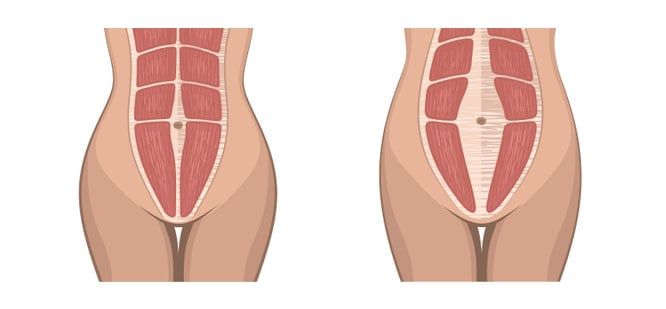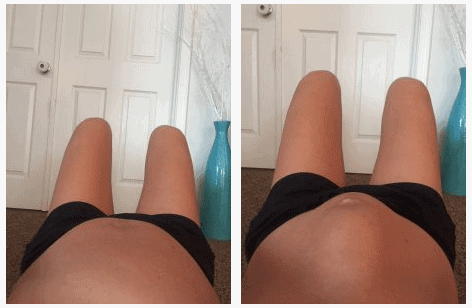Despite the fact that it may actually be the most common side effect of pregnancy, many women are largely unfamiliar with the term “diastasis recti” and what it can mean for their bodies before, during, and after growing and birthing a tiny human. We’ve rounded up the 8 most common questions that women ask about diastasis recti (once they’re finished figuring out how the hell to pronounce it).
Oh, it’s die-a-stay-sis wreck-tie, by the way.

What the hell is it?
Put simply, diastasis recti is an asshole. On second thought, it would be more accurate to say that it’s an “ab-hole” (because “abdominal separation” just isn’t as punny). The word “diastasis” means “separation” and “recti” is another word for your ab muscles, which you have likely never referred to as your “rectus abdominis”. Congratulations, you now speak Latin, and know a little bit more about one of the tragically under-discussed, and unfortunately, very common, side effects of pregnancy.

Who gets diastasis recti?
Great news! Literally, 100% of pregnant women will experience diastasis recti to some degree by 35 weeks gestation. This is because (spoiler alert!) while you’re pregnant, your abdomen has to expand to accommodate your sweet little bundle of joy. Have you ever noticed that light brown line that might run down your belly during pregnancy? It’s called the “linea nigra” (Latin for “black line”) and it was formerly your “linea alba” (“white line”).
That line, regardless of what color it is, is created by connective tissue that holds your left and right abdominis muscles together. During pregnancy, that connective tissue is stretched (also thanks to the hormones estrogen and relaxin), and the intra-abdominal pressure combined with a weakened core and shifted body alignment all contribute to our main man, diastasis recti.
Why does diastasis recti happen?
While it was once believed that pre-pregnancy weight, pregnancy weight gain, or the size of the baby were to blame for diastasis recti, studies have shown that this isn’t actually the case.
Some factors that may increase your chances of having diastasis recti include the following:
- Multiple pregnancies, particularly if they are close together
- Being pregnant with more than one baby
- Weak abdominal muscles prior to pregnancy
- Improper or excessive abdominal exercise after the first trimester
How do I know if I have diastasis recti?
One pretty good sign of diastasis recti (postpartum) is a belly “pooch” that just won’t hit the road. If, like me, you’re struggling to determine if the bulge is due to that extra helping of Chipotle or if something more stubborn is to blame, there is a quick little test you can do to find out for sure.
How to Test For Diastasis Recti:
- Lie on flat on your back with your knees bent.
- Put your fingers right above your belly button and press down gently.
- Lift up your head about an inch while keeping your shoulders on the ground.
- If you have diastasis recti, you will feel a gap between the muscles that is wider than an inch (2.5 cm).
- If you aren’t totally sure what you are feeling for, you can visit your doctor or physical therapist who can use a caliper or ultrasound to check for diastasis recti.
What happens if I have diastasis recti?
- Don’t panic. As mentioned above, diastasis recti is totally normal.
- Diastasis recti is commonly referred to as a space of at least 2.5 cm between the abdominal muscles. Unfortunately, the weakened abdominal wall and connective tissue are unable to support the abdominal organs as well as they once did, resulting in a belly “pooch” that many have dubbed “the mummy tummy”.
- In rare cases where the connective tissue tears, abdominal organs can sneak through the tear creating a totally different kind of bulge. The hernia kind.
- A weakened core can lead to pelvic floor dysfunction, which includes such fun symptoms as leaking urine, constipation, and flatulence incontinence, as well as organ prolapse. A 2007 study by Spitznagle et al found that 66% of women with diastasis recti had “some level of pelvic floor dysfunction”. Yikes!
- Diastasis recti can also lead to lower back pain, as the weakened abdominal muscles aren’t able to properly support the spine.
What makes diastasis recti worse?
- Planks. Sit-ups. Push-ups. For real. Even though it goes against what your instinct (and the cover of many magazines at the grocery store) will tell you, these exercises can do more harm than good, particularly if you aren’t doing them properly. This is because they press your abdominal organs against the gap between your abs, which you definitely want to avoid if you have diastasis recti. If you’re doing these exercises and notice that your belly looks pregnant or football-shaped, it could be a sign of diastasis recti, so turn off the workout video and see your doctor to find out whether you should continue or not.
- Backbends. According to Leah Keller of Every Mother, this stretch can exacerbate and even cause diastasis recti. In addition, she mentions that any exercise that lifts your shoulders or both legs off of the floor from a back-lying position where your abs aren’t totally flat can also cause damage. If you are doing any type of exercise where you aren’t able to monitor whether your core is correctly engaged and your abs might be bulging out, it’s time to find a different workout.
- Getting out of bed. Sorry, this isn’t a free pass to hang out under the covers all day, but it is a friendly reminder that it’s better for you to log roll out with bent knees and the support of your arm rather than just jumping straight up to greet the day as I’m sure you normally do.
- Heavy lifting, which means anything from your kiddo to that piano you’ve been dying to move, so save the redecorating for later.

What makes diastasis recti better?
- For the majority of women, the stretching of the linea alba and connective tissue is minor enough that it can heal itself and by 6 months postpartum, approximately 60% of women were no longer experiencing diastasis recti.
- Practicing good posture and maintaining proper alignment is always a good idea, but particularly so when you have diastasis recti, as it reduces the pressure on your abdominal cavity and gives the gap between your abdominal muscles a better chance to heal.
- A quick search on Google or Pinterest will bring up a variety of exercises and programs that women have tried to help heal their diastasis recti. Unfortunately, many exercises you can find on the web are not backed up by research and science and may do more harm to your core than good. But don’t despair! Programs like the Mutu System, the Tupler Technique, and Every Mother have been researched and carefully developed to provide moms with exercises created specifically for women with diastasis recti. It’s probably a good idea to consult with your doctor before starting any particular exercise program.
- If you have a large, stubborn gap that isn’t responding to time or treatments that you have tried, surgery is another option. The cost for this surgery hovers around the $10.000 mark.
How can I prevent diastasis recti?
Unfortunately, there is no way to prevent Diastasis Recti that is guaranteed to be 100% effective, but it definitely doesn’t hurt to try.
- In case you needed a reason to start strengthening your core, the best time to start is before you get pregnant. No amount of crunches will prevent your belly from growing during pregnancy (duh!), and ab exercises may put you at risk for abdominal splitting. Always consult your doctor if you have questions about what types of exercises you should be doing during pregnancy.
- This study has some good news: it found that only 12.5% of pregnant women who exercised using proper core-strengthening methods targeting the transverse abdominis experienced diastasis recti while 90% of pregnant women who did not exercise found themselves affected with the condition. In other words, get the go-ahead from your doctor and find yourself a good core-strengthening program, mama!
- Maintain good posture during pregnancy by getting the support you need – the belly support, that is. Belly support bands can help lift your belly to keep your body aligned and reduce pressure on the space between your abdominal muscles.
- Roll out of bed rather than pulling yourself up and putting extra pressure on your abdominal muscles.
Are there any important questions (or answers) that we missed?
Feel free to post them in the comments. We’d love to hear about your experience with diastasis recti!
Our next reco: Hemorrhoids During Pregnancy: Safe Tips, Tricks, and Treatments




Leave a Comment